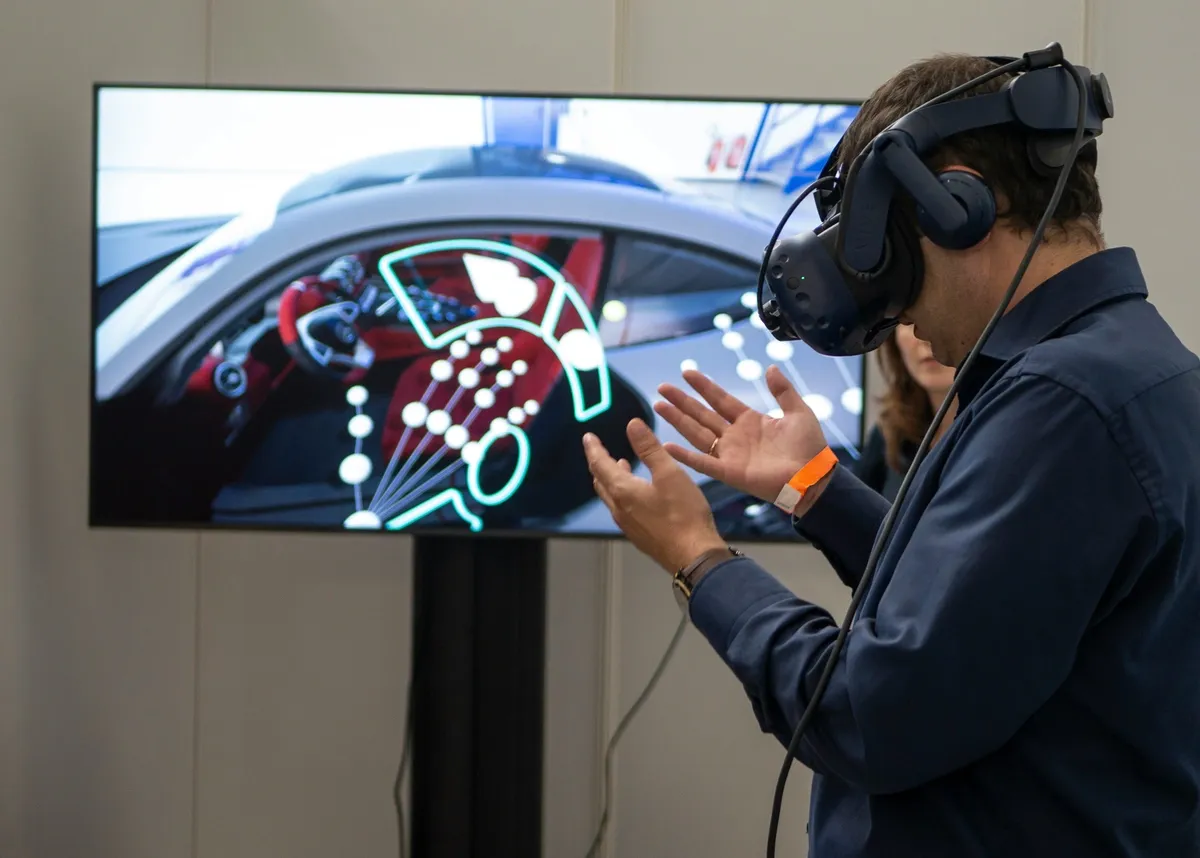
Augmented Reality (AR) is revolutionizing the engineering industry by offering enhanced project visualization capabilities. This cutting-edge technology allows engineers to overlay digital information onto the physical world, resulting in more accurate project designs and improved collaboration among team members and stakeholders. As AR continues to advance, its applications in engineering projects are proving invaluable for on-site inspections, real-time problem-solving, and superior client presentations, thereby driving efficiency and reliability in project execution.
Understanding Augmented Reality (AR) in Engineering
Augmented Reality (AR) is a transformative technology that overlays digital data onto real-world environments to enhance user understanding. Unlike Virtual Reality, which immerses users in a completely artificial environment, AR enriches the existing surroundings by superimposing 3D images and contextual information. This allows engineers to visualize and manipulate 3D CAD prototypes in a collaborative setting from anywhere in the world, making project design and execution more interactive and efficient (source).
The journey of AR in engineering began in 1968 when Ivan Sutherland introduced the first head-mounted display, known as The Sword of Damocles. This was followed by Myron Krueger’s creation of an interactive AR environment in 1974. The term “Augmented Reality” was officially coined in 1990 by a researcher at Boeing. During the mid-90s, AR found its initial applications in aerospace and military engineering, aiding engineers in diagnosing and repairing machinery by projecting holographic objects onto physical components (source).
Today, AR has evolved from an entertainment medium to a crucial business tool. Key trends include the integration of Artificial Intelligence with AR, the rise of mobile AR for business applications, and the development of WebAR for more accessible experiences. Engineers now use AR not only in the design phase but also for component assembly, maintenance support, and repair procedures. The technology enhances productivity by allowing for accurate conclusions from 3D prototypes and facilitating effective communication among engineers, business leaders, and stakeholders (source).
AR is redefining engineering by integrating digital information with physical assets, thereby improving productivity and ensuring product quality. It helps identify and resolve issues before they can disrupt development timelines or impact customer satisfaction, making it an indispensable tool in modern engineering (source).
Benefits of AR for Project Visualization in Engineering
Augmented Reality (AR) offers numerous benefits for project visualization in the engineering sector, greatly enhancing the overall accuracy, collaboration, and stakeholder engagement throughout the project lifecycle.
Enhanced Accuracy in Project Design and Planning
AR significantly boosts accuracy in project design and planning by allowing engineers to create, visualize, and manipulate 3D Computer-Aided Design (CAD) prototypes in a shared digital environment. This capability enables engineers to simulate and scrutinize intricate details of a project before actual implementation, thus reducing errors and rework. The ability to interact with 3D prototypes helps engineers make precise conclusions, thereby increasing productivity at each stage of the project (source). Additionally, AR enhances spatial intelligence across the team, ensuring everyone from engineers to business professionals can visualize and comprehend the 3D prototype, leading to a more accurate and comprehensive design process (source).
Improved Collaboration among Team Members and Stakeholders
AR technology fosters enhanced collaboration by providing a shared platform where team members and stakeholders can interact with 3D models, review plans, and identify potential issues in real-time. This collaborative environment minimizes misunderstandings and facilitates quicker decision-making, allowing for a more holistic approach to problem-solving. By visually aligning the project’s goals and progress, AR ensures all stakeholders are on the same page, thereby streamlining project management and execution (source).
Superior Client Presentations and Stakeholder Engagement
The application of AR in client presentations creates immersive and interactive experiences that enhance comprehension and engagement. Presenting data in three dimensions allows clients to better understand complex concepts and see the tangible benefits of proposed solutions. This immersive approach is particularly effective in high-stakes meetings or sales pitches, as it can communicate the value proposition more compellingly than traditional methods. AR presentations not only make complex data more understandable but also foster a deeper connection with the audience, thereby enhancing stakeholder engagement and satisfaction (source).
Case Studies or Examples of Successful AR Implementation
Several successful implementations of AR illustrate its potential in transforming project visualization and execution:
- IKEA Place: IKEA’s AR-powered app allows users to place virtual furniture in their homes to see how it fits and looks. This innovation led to a 98% increase in conversions for customers using the AR app compared to those who did not.
- Pokémon GO: This mobile game integrates AR to overlay virtual creatures onto the real world through smartphone cameras, revolutionizing mobile gaming and capturing millions of users’ attention.
- Microsoft HoloLens: This AR headset has transformed remote assistance in industries like manufacturing and healthcare. Companies using HoloLens have reported a 25% decrease in service resolution time (source).
In conclusion, AR technology is a powerful tool for enhancing project visualization in engineering. It improves design accuracy, fosters collaboration, and elevates stakeholder engagement, making it indispensable for modern engineering projects. Minute7 supports engineering firms in optimizing these benefits through efficient time tracking and expense reporting, ensuring project efficiency and cost-effectiveness.
Practical Applications of AR in Engineering Projects
AR for On-Site Inspections and Real-Time Problem-Solving
Augmented Reality (AR) is revolutionizing on-site inspections by overlaying digital information onto physical objects, providing inspectors with guided checklists and highlighting critical points. This technology ensures adherence to specifications and reduces the risk of oversights. Advanced AR systems integrated with Artificial Intelligence (AI) can automate defect detection, saving time and minimizing human error. Additionally, AR provides visual and step-by-step instructions to engineers and technicians, enhancing task efficiency and accuracy during maintenance and repair (source, source).
Integration of AR with Existing Engineering Tools and Software
Integrating AR with existing engineering tools and software, such as CAD applications, brings significant benefits. AR can display conceptual designs as they appear in the real world, enabling users to test various options before physical construction. Some CAD software, including SOLIDWORKS, Autodesk, PTC, and Augment, employs AR to showcase designs in full scale within the intended environment. This integration allows clients to visualize product concepts accurately and simulate them in real-world settings, enhancing design validation and client satisfaction (source, source).
Steps to Implement AR in an Engineering Firm
Implementing AR in an engineering firm involves several key steps:
- Identify Needs and Goals: Determine specific engineering needs and project goals to tailor the AR solution.
- Choose the Right AR Technology: Select AR technology based on usability, compatibility with existing tools, and cost.
- Develop an Implementation Plan: Create a plan that includes staff training, integration with existing workflows, and evaluation measures.
- Pilot Projects: Start with pilot projects to test and refine the AR solution before full-scale implementation.
- Evaluation and Feedback: Continuously evaluate the AR solution’s effectiveness and gather feedback for improvements (source).
Challenges and Solutions in Adopting AR Technology
Adopting AR technology in engineering comes with challenges such as high costs, the need for specialized training, and potential staff resistance to change. However, these challenges can be addressed by:
- Demonstrating Benefits: Highlighting AR’s advantages to gain buy-in from stakeholders.
- Providing Training: Offering comprehensive training programs to ensure proficient use of AR tools.
- Gradual Integration: Integrating AR gradually into existing workflows to minimize disruption.
- Cost-Effective Solutions: Choosing cost-effective AR technologies compatible with current systems (source).
By overcoming these challenges, engineering firms can leverage AR to enhance project visualization, streamline processes, and improve overall efficiency. Minute7 supports engineering firms by providing efficient time tracking and expense reporting solutions, ensuring projects are completed on time and within budget.
Leveraging AR for Comprehensive Project Management
Augmented Reality (AR) has indisputably become a transformative tool in the engineering sector, enhancing project visualization and facilitating more efficient workflows. By integrating AR, engineering firms can achieve greater accuracy in design and planning, foster improved collaboration among team members, and deliver superior client presentations that boost stakeholder engagement. The successful case studies and practical applications highlighted in this article demonstrate the expansive potential of AR to revolutionize engineering projects.
However, the true value of AR is unlocked when it’s combined with robust project management solutions like Minute7. Minute7 complements AR technology by offering precise time tracking and expense reporting, ensuring that engineering projects remain on schedule and within budget. The seamless integration with QuickBooks and other accounting packages allows firms to synchronize data effortlessly, providing a comprehensive overview of project progress and financial health.
By adopting AR and leveraging Minute7’s capabilities, engineering firms can navigate the complexities of modern projects with greater confidence and efficiency. This synergistic approach not only enhances project visualization but also optimizes resource management, ultimately leading to more successful project outcomes. Embrace the future of engineering with AR and Minute7, and experience unparalleled productivity and project success.



